Editorial
As you will know, if you are reading this, the URL change forecast last month has actually happened. You probably arrived here via the auto-redirect I've placed in the standard entry point at the old URL. All the pages that were located at the old URL (http://archive.dstc.edu.au/BDU/staff/ron) are still there, and will remain accessible for the foreseeable future, but no new material will be added. That will all take place here at the new URL for Model Engine News:
http://staff.dstc.edu.au/chernich/ron
The change was not without pain and took longer than expected, so the you-know-what has been pushed off for another month (sigh). By the way, the DSTC domain and its future is still uncertain. In the worst case scenario, it will cease to exist from July 2006, but many people are working very hard to see it continue past this date, in some form or other.
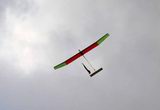 The F1A pictured here is not mine, but I thought is was nice and it reminds me, with a tear in the eye, of the one I had go bye-bye at the Queensland State Champs this past month. In round two, it DT'd perfectly at just under the 3 minute max mark, but the air it was in was going up much faster than the model was prepared to come down—a deplorable situation that continued to exist for an extra special long time and might still exist for all I know! After over an hour, even the tracker signal faded out with the DF Yagi still pointing significantly above the horizon. Talk about a thermal to end all thermals... Grrrrr... One nice model and one expensive tracker bug gone. Not my year for gliders, obviously.
The F1A pictured here is not mine, but I thought is was nice and it reminds me, with a tear in the eye, of the one I had go bye-bye at the Queensland State Champs this past month. In round two, it DT'd perfectly at just under the 3 minute max mark, but the air it was in was going up much faster than the model was prepared to come down—a deplorable situation that continued to exist for an extra special long time and might still exist for all I know! After over an hour, even the tracker signal faded out with the DF Yagi still pointing significantly above the horizon. Talk about a thermal to end all thermals... Grrrrr... One nice model and one expensive tracker bug gone. Not my year for gliders, obviously.
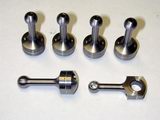
Shop-wise, I've made progress with the Cirrus that I'm neither completely pleased with, nor entirely dissatisfied with. And, as usual, I sat down to compose this page wondering how I could fill it, only to end up with a record 11 news items on top of the four standard features (if you can count my editorial mumblings as a feature). So it will be a good month, and if you are a charter subscriber, by the end of April you should have Issue #1 of Model Engine Builder in your hands. Full review to follow this blessed event, naturally. Now, down to business...
Saturn Falcon AAC
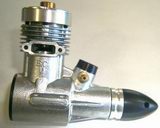
Here's a 2.5cc compression ignition engine that's a bit unusual. Called the Falcon, it's made by Tony Cincotta's Saturn Hobbies in Australia. The case is of Russian origin (obvious from the Cyrillic script), but Tony is producing his own AAC piston/liner sets for it, and as a retro-fit item for the OS .46. Normally we'd read "AAC" as "aluminum piston, aluminum liner, chrome plated", but in this case, the "C" means ceramic coated! Amongst other benefits, this results in a very light yet durable combination (19.4 grammes compared to 41.1 in the case of the OS retro-fit unit), making Tony's motors very high-tech indeed. I've not handled one, nor seen one run, but the price quoted is most reasonable for a sport motor. Read about it on the Saturn web site—especially the AAC Torture Test. Saturn also sells a nice range of classic control line and free flight kits and will ship overseas.
Les Stone's Deller
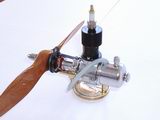
Les is never at a loss for an unusual subject to make. This month (!!) it has been the 1cc spark ignition engine designed by Mr WH Deller in 1938, making this quite a pioneering effort. Les' example bears all his trademarks and the details, plus many more pictures have been added to the Les Stone Tribute Page of the gallery. The Deller is also the featured Engine of the Month, making this the second time in a row that Les has set the subject for review... most welcome!
Battiwallah Special
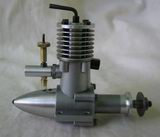
Vincent Chai has been quietly (and occasionally noisily) developing the ancient and humble Battiwallah design (see Model Engine News, April 2003). He wants to find out just how far a 50+ year old design can be taken with all those intervening years of advancement to draw upon. The latest iteration, the Battiwallah Special, has a bore of 11.40mm, and a stroke of 14.30mm to give a swept volume (sometimes incorrectly IMHO termed capacity) of 1.46cc. It turns a 6x4 at 17,300 RPM and produces instant noise complaints from the neighbors. Vincent says it is very responsive on these small props, but inefficient running at below 10,000 RPM, so not your typical side-port. He wisely starts it with a chicken-stick and is planning the next version which will have a slightly shorter stroke, lighter piston, and Schnuerle transfer boost ports, if he can squeeze them in.
Cirrus Progress
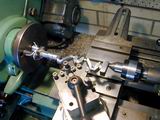
The first Cirrus crankshaft took shape during the month. I say "first" because there may yet be a second. Photos have been added to the Cirrus Project Page; the one here showing the crank webs being taper turned to profile. This was one Big Interrupted Cut job. Much banging. Much teeth clenching. And all carried out at slow speed to prevent chatter due to the tool overhang required to clear all the spinning bits. Makes me feel I should build a crankshaft grinder and make another shaft—although making the grinder would be a project almost as complex as the entire engine (Ok, I just remembered the camshaft, so maybe not quite as complex). At the time the picture was taken, the journals had only been roughed to shape and size under the mill. This seemed much easier and less risky than an interrupted cut using a long and largely unsupported 3/16" square HSS tool. When I'm more confident that this is fully viable, it may get dignified as a Tech Tip, but in the meanwhile, a problem facing the conrod big-end caps has yielded a simple tip on how to set up thin parts to run true in the 3 jaw chuck.
Philtech V6

Some time back, the Philtech Diesels were subjected to review using examples from the collection of Mr Van Richards-Smith (who is still trying to collect all the colors, now that we know how many there were). A nice and unexpected email arrived during the month from Phil Morton, Mr Philtech himself. Phil pointed out a couple of errors in the article, thankfully relatively minor—minor that is if he can excuse my misspelling of the company name  —and cleared up the mystery of the color coding of the crankcases. So revisit the page to read all about it. Philtech no longer make the little diesel, but they do still produce their remarkable modular V series engine pictured here. Phil has promised details for the future, but for those who can't wait, visit the Philtech web site.
—and cleared up the mystery of the color coding of the crankcases. So revisit the page to read all about it. Philtech no longer make the little diesel, but they do still produce their remarkable modular V series engine pictured here. Phil has promised details for the future, but for those who can't wait, visit the Philtech web site.
Goldburg Valkyrie
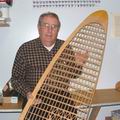
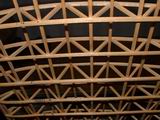
Tim Danels, editor of The Engine Collectors Journal, has a long-time addiction to a large free flight power model designed way back when by Carl Goldburg, namely the Valkyrie. This model dates back to when large airframes were needed to carry aloft the ignition engine with its associated mass in coil and batteries. It also dates back to a time when 1/8" square balsa was a lot cheaper than it is now! I've included these pictures of Tim and a Valkyrie wing because I think the structure is pure poetry. The top and bottom rib forms are actually cut to the required width and curvature from 1/8" sheet, sliced off I-Beamer style (if you know what I mean). This enables all ribs to be cut the same size, then trimmed at the rear to fit between TE and LE giving automatic airfoil correction as the wing tapers. Lower spars are then added, followed by the rib upper camber strip (again trimmed at the TE only). Upper spars are fed in and glued up, followed by the Warren Truss diagonals. It all results in a light weight, but strong structure that Tim says goes together remarkably quickly. A thing of beauty and a crime to cover—and that's my excuse for why the last I-Beam stunter I built is still uncovered  .
.
Chenery Correction
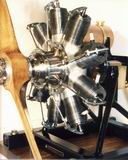
A nice email last month from John Chenery alerted me to a small error in the contact details for his father, Les Chenery, in the Suppliers Page. As regular readers of these pages will know, Les is a prolific designer of advanced, working, scale aero engines. His designs have been serialized in the Model Engineer from time to time and he supplies plan sets and castings (for some) for a reasonable price. The engine seen here is Ron Colonna's rendition of the Chenery Gnome Monosaupape. As well as supplying the correction, John has kindly offered to act as an email conduit to his father (whose time is better applied to engine designing and building than playing around with computers). John's email has been added to the Suppliers' entry, but for the lazy, it is [email protected].
A Pride of Mk 17-4s's
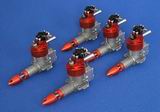
A number of people were most taken with Peter Tarn's conversion of the Russian Mk 17 two-stroke diesel to a four-stroke glow that appeared here almost a year ago in the May 2004 issue. Ken Croft, who sent the pictures of Peter's one-of-a-kind has followed up with photos of a small production run of the conversion made by Dietmar Kolb in Germany. The photos show superb workmanship and a fine eye for artistic engine arrangement (post-grad degree course to follow  ).
).
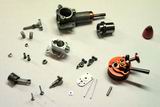 Ken visited Peter to get more information about the conversion. Peter obliged and as he had his example in pieces for maintenance at the time, Ken was able to make an exploded-view picture. The eagle-eyed will immediately spot the fact that the four-stroke cylinder carries two-stroke ports! What Peter did was to retain the original cylinder liner, but lower the deck height of the cylinder so that no port is opened when the piston is at BDC. This is practical because the removal of the contra-piston provided extra room for piston movement in the cylinder—although the bottom of the liner needed to be ground away to clear the crank disk. It occurs to me that the lowered "exhaust" will provide a *lot* of what we'd normally call sub-piston induction. This is good for the case breathing required by 4 strokes, but will result in unnecessary primary compression at BDC that will be costing some available power.
Ken visited Peter to get more information about the conversion. Peter obliged and as he had his example in pieces for maintenance at the time, Ken was able to make an exploded-view picture. The eagle-eyed will immediately spot the fact that the four-stroke cylinder carries two-stroke ports! What Peter did was to retain the original cylinder liner, but lower the deck height of the cylinder so that no port is opened when the piston is at BDC. This is practical because the removal of the contra-piston provided extra room for piston movement in the cylinder—although the bottom of the liner needed to be ground away to clear the crank disk. It occurs to me that the lowered "exhaust" will provide a *lot* of what we'd normally call sub-piston induction. This is good for the case breathing required by 4 strokes, but will result in unnecessary primary compression at BDC that will be costing some available power.
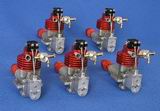
Peter's valves are titanium—mostly because he had some. The steel rockers are formed by rebating both sides of a disk, then milling away the top and bottom bits that don't look like a rocker. The carb is a G-Mark item, faithfully copied by Dietmar on his small run. Notice the use of helical gears for the cam drive. These are stock HPC items Locktited to their shafts, as are the cams—a feature that Ken and I agree could be improved upon and the reason the engine was down for maintenance. Still, a neat and successful achievement which many find most appealing in appearance and novelty.
The anodizing on Peter's and Dietmar's engines is most attractive too, which provides the perfect segue into the next item...
Another Anodizing Info Site

The Model Engine News web site initially began as a simple tale about back-yard anodizing. Obviously it's grown a little since, but I still do the occasional restoration that calls for a spot of color anodizing. Like most hobby related activities, as one's experience and skill expands, so can one's dissatisfaction with how aspects are accomplished. I've felt for some time that I could do a lot better in the coloring department, and knew what was required: actual anodizing dyes rather than those I've been forced to use. Last month, Roger Schroeder made me aware of a very good web site dealing with amateur and semi-pro anodizing: http://www.focuser.com/atm/anodize/anodize.html. The site was put together by Ron Newman who shows many of his setups and discusses the broad processes involved. For the serious, he offers a book, and starter kits of supplies. Even better, he ships overseas! I've ordered both book and kit and will report again when it arrives.
New Books and Magazines This Month
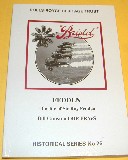
Biographies, I'll admit, are not to every one's taste, or perhaps they are an acquired taste. The prospect of sitting down to read the life and times of some politician is not something I could stomach, but the life and times of some aero engine and the people who developed it is a different matter—leading us obtusely to this month's selection. I'll kill off the suspense up front: I liked this book immensely and recommend it unreservedly to people who love aero engines, especially "round" ones. Now as to why...
The biographer is the noted aviation historian, Bill Gunston. I have a couple of his engine related works in The Library, but was amazed to find out just how prolific he is as a writer—over 300 titles! This particular book is a revision of his earlier work titled "By Jupiter", which, if we're doing cutesy titles, would probably have been better titled Buy Jupiter, as that is precisely what the aviation world did, in large quantities. However the revised title better reflects what the book is really about: a brilliant, highly focused engineer named Roy Fedden (later, Sir Roy). It traces his career from a time when engineers were considered "tradesmen" by British society—the sort who would be required to come calling via the back door—through the Twentieth Century's two World Wars, and relates Fedden's remarkable direct and indirect influence on aviation and engineering in general as he strove to change English culture and manufacturing process.
In the Foreword, Gunston relates how he required two attempts to complete this book. It was begun in close collaboration with Fedden, and later abandoned by mutual agreement. Once you begin to understand what a... how shall I put it? ...a totally "self-confident" person Fedden was, this is not at all hard to imagine. It was completed after Fedden's death, and as noted earlier, has undergone a significant revision and expansion since first publication with new photographs and text. Story wise, it primarily traces the development of the Bristol Jupiter radial (and variants), and the Bristol sleeve-valve radials. Success in achieving mass-production of the latter was achieved only by a happy accident, benefiting Britian's war-effort enormously. In doing so, it also traces the history of the Bristol company, and the other companies that felt Fedden's influence throughout his remarkable life. For me, it tied together a number of names that I'd previously seen only in isolation, contributing further to the Great-Inter-Connectedness-Of-Everything theory.
As most will be aware, Bristol aero engines were acquired by Rolls-Royce, as, it sometimes seems, has been just about every other aero engine maker from Allison to Junkers! This is fortunate because the Rolls-Royce Heritage Trust is doing a great job of preserving the history and identity of these companies through their many excellent publications. "Fedden", Number 26 in the Trust's Historical Series, by Bill Gunston OBE FRAeS, R-R Historical Trust 1989, ISBN 1 872922 13 9, is available from the Trust, with a worthwhile discount to members. My copy was most kindly provided by John Strachan of Hobby Mechanics, the only official second source of castings for the Quorn Cutter Grinder. All are highly recommended.
Engine Of The Month: 1938 Deller 1cc Spark
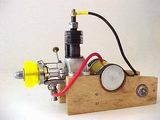
Here's an engine that I was blissfully unaware of until Les Stone sent me pictures of his newly completed (and run) example. However, the English Motor Boys tell me that it is still well remembered in its land of origin, and Ken Croft quickly provided scans of the original 1938 NEWNES PRACTICAL MECHANICS article. The drawings showing the machining steps are quite a work of art and the engine itself has a number of unique features. Read all about it on the Deller page.
Tech Tip of the Month: Tricky Workholding
Just a quickie this month, giving a hopefully adequate solution to a tricky problem: how to set up thin parts in the 3 jaw self centering chuck to run true for second operations. Say you have a thin, round thing where the diameter is much greater than the thickness. For whatever reason, it needs to be gripped to run true for facing. What do you do?
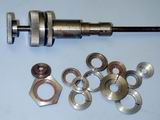
The venerable pot chuck is one answer, provided the back side of the piece is parallel to the side to be faced—but you probably will have to make the pot chuck. This becomes a 30 minute solution to a 30 second problem. I've also seen all kinds of elaborate chuck back-stop devices described in magazines, and even made one as seen here. The idea being something that fits into the headstock spindle with an end face (out of picture to the right) that is perfectly normal to the lathe axis. This is fitted to a rod that can be adjusted in position along that axis and locked in position. The end face is smaller in diameter than the thing to be gripped, so in theory, the part can be pushed back against the face as the jaws are tightened, thus aligning it for facing. It will also prevent axial forces pushing the part back into the chuck, and can act as a back-stop for repeatability on "production runs". But you'll spend a day making the basic parts, and still have to make a new backstop pad for just about every job. In short, while both are reasonable solutions when serious quantity production is involved, they are less than idel for one-off jobs.
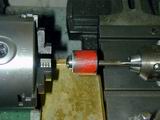
Here's my quick 'n dirty solution. In this case, neither a pot chuck, nor a chuck back-stop would have worked anyway because the rear of the part was convex (the conrod caps for the Cirrus Mk I). The other side was flat, but needed 20 thou faced off due to a stupid measurement error I don't want to talk about right now. I was thinking of making an "anvil" that could be gripped in the tailstock mounted drill chuck and pushing the parts against it as I tightened up the chuck when I spotted a shop magnet which with a tapped body. Some quick tests showed it was threaded 0BA (!?), and another quick test showed that when screwed onto a 0BA bottoming tap, the error across it's face measured with a plunger DTI was near enough to unmeasurable—certainly close enough for jazz! The photo shows a cap being presented to the 3 jaw chuck for gripping prior to facing. After tightening up, the tailstock is easily pulled away. What could be simpler? I may even make up a threaded rod to replace the temporary shank and make this a "permanent" shop tool. Obviously, the trick is not going to work as well for non-ferrous materials, and as the setup is delicate, the cuts must be light. But it worked fine for me on the five Cirrus conrods (I don't want to talk about that either...)
ENYA 19 Line-up
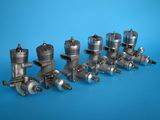
I could not resist including this photo sent in by a reader. It shows, so I'm reliably told, all six marks of the ENYA 19. Just shows what some thoughtful arranging and lighting can do for an otherwise uninspiring subject (maybe the PhD in Advanced Engine Arrangement is not so silly afterall). From left to right, we have the 4001, 4002, 4003, 4004, 4005, and 4006. Sadly, the ENYA 4001 has been "restored" with a wire brush which has removed the original red anodizing from the head and prop driver (this small but significant detail spotted instantly by Motor Boy David Owen). More information about the ENYA 19 can be found at the Supercool Racing Propellers web site.
Hodgson 9 Development Program
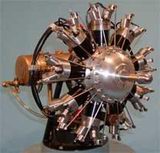 To close off this month, Lee Hodgson of Ageless Engines sent me an email saying nice things about the Edgar T Westbury articles and the AEHS item from last month. I've always said Graft is Great, but kind words will do in a pinch, so I've included this last minute information from Lee detailing the three year continuous development program he has been engaged in, seeking to improve the starting and throttle characteristics of Ageless 9 cylinder radial (the plans for this engine were reviewed here in the March 2004 Books and Magazines). All the Hodgson engines I've seen run started just fine, but no true engineer is ever satisfied, and Lee's modifications show real commitment to his customers. Rather than paraphrase the data, I've created a page detailing the Hodgson 9 Cylinder Radial Improvements for 2005. If you are a plan set owner, or would like to be, contact Ageless Engines for further details.
To close off this month, Lee Hodgson of Ageless Engines sent me an email saying nice things about the Edgar T Westbury articles and the AEHS item from last month. I've always said Graft is Great, but kind words will do in a pinch, so I've included this last minute information from Lee detailing the three year continuous development program he has been engaged in, seeking to improve the starting and throttle characteristics of Ageless 9 cylinder radial (the plans for this engine were reviewed here in the March 2004 Books and Magazines). All the Hodgson engines I've seen run started just fine, but no true engineer is ever satisfied, and Lee's modifications show real commitment to his customers. Rather than paraphrase the data, I've created a page detailing the Hodgson 9 Cylinder Radial Improvements for 2005. If you are a plan set owner, or would like to be, contact Ageless Engines for further details.
 Saturn Falcon AAC
Saturn Falcon AAC
 Les Stone's Deller
Les Stone's Deller
 Battiwallah Special
Battiwallah Special
 Cirrus Progress
Cirrus Progress
 Philtech V6
Philtech V6
 Goldburg Valkyrie
Goldburg Valkyrie
 Chenery Correction
Chenery Correction
 A Pride of Mk 17-4s's
A Pride of Mk 17-4s's
 Another Anodizing Info Site
Another Anodizing Info Site
 ENYA 19 Line-up
ENYA 19 Line-up
 Hodgson 9 Development Program
Hodgson 9 Development Program
 Editorial
Editorial
 New Books and Magazines This Month
New Books and Magazines This Month
 Engine Of The Month: 1938 Deller 1cc Spark
Engine Of The Month: 1938 Deller 1cc Spark
 Tech Tip of the Month: Tricky Workholding
Tech Tip of the Month: Tricky Workholding
 Standard Stuff
Standard Stuff







 —and cleared up the mystery of the color coding of the crankcases. So revisit the page to read all about it. Philtech no longer make the little diesel, but they do still produce their remarkable modular V series engine pictured here. Phil has promised details for the future, but for those who can't wait, visit the
—and cleared up the mystery of the color coding of the crankcases. So revisit the page to read all about it. Philtech no longer make the little diesel, but they do still produce their remarkable modular V series engine pictured here. Phil has promised details for the future, but for those who can't wait, visit the 











